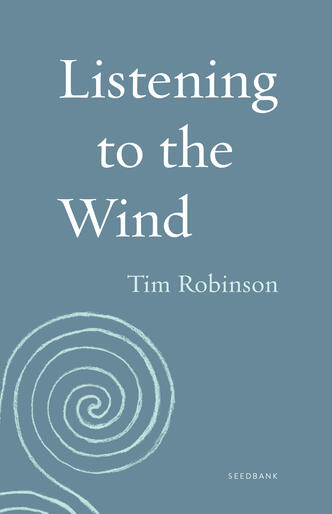Excerpt: Introduction to Tim Robinson’s Listening to the Wind
Introduction to Tim Robinson’s Listening to the Wind, a Seedbank series title.
On the west coast of Ireland, in the northwestern corner of County Galway, lies the region of Connemara. Its rugged Atlantic shoreline and landscape of peat bogs, low mountains, and chains of lakes and rivers—a “recalcitrant reality,” in the words of Tim Robinson, inherently resistant to any kind of “rectilinear abstraction”—have been inhabited for thousands of years. Much like the bogs, in which the detritus of thirty or forty centuries of plant life are compressed into a few feet of incomparably dense material, the resulting strata of human culture are ancient and rich. It is this place that is evoked by Robinson in Listening to the Wind, along with a notion of what “right living” might mean in such a place.
A native of Yorkshire, Tim Robinson studied mathematics at Cambridge, then worked for many years as a painter and visual artist, living in Istanbul, Vienna, and London. In 1972, he and his wife moved to the Aran Islands. In 1986, his first book, Stones of Aran: Pilgrimage, was published to considerable acclaim. A subsequent volume, Stones of Aran: Labyrinth, appeared in 1995, completing the first major chapter in what Robert Macfarlane has described as “one of the most sustained, intensive, and imaginative studies of a landscape that has ever been carried out.” In 1984, Robinson and his wife moved to Connemara and took up residence in a historic seaside home they call Nimmo House, after the engineer who designed the harbor and founded the village of Roundstone in the 1830s. Here, Robinson developed his practice of cartography, restoring Irish place names—irreplaceable, often mysteriously evocative words that have been disappearing in the wake of cycles of colonization, famine, and emigration—and established a small press called Folding Landscapes, which has published his maps and writings. And he set about writing a singular trilogy of books—a deep map of sorts—on his adopted homeplace, of which Listening to the Wind is the first volume.
In contrast to much of the literature of place more familiar to American readers, it is clear from the outset of this extraordinary book that Robinson’s orientation toward the past is fundamental to his approach. He begins with an extended reflection on a small, nondescript cross standing alongside a road following a stream to the sea. Unmarked, the grave is said to be that of a young man of modest means who suffered a heart attack, the first of many spirits and ghosts evoked in these pages. It is arguably not the story of the man’s life that seems to interest Robinson, however, nor that of his death. Rather, he writes,
Whatever the burden of the gillie’s last breath, it was dispersed into the air to be degraded by the hiss of rain or eroded molecule by molecule in the Brownian fidget of drifting pollen grains, and captured, a little of it, by the tilting, spilling cups and saucers of the water surface, dissolved, hurried under the old bridge at Tuaim Beola and added to the sea. So one can imagine it infinitesimally present in, and persuasively interpreting, the sough (which we should not delude ourselves is a sighing) of the Ballynahinch woods, the clatter (not a chattering) of the mountain streamlets, the roar (not a raging) of the waves against the shore.
There is much to be found in this passage that is essential to Robinson’s vision. The deep interest in what he describes elsewhere as “the sound of the past, the wreck of time’s grand flow in tortuous passages” is particularly striking, though he is careful to distinguish his manner of listening to the past’s “agonistic multiplicity” from those who would perceive a more systematic “sound of history,” with its “rhythms, tunes and even harmonies.” The insistent parenthetical qualifications are of more than formal interest as well, for Robinson’s staggering depth of knowledge and intellectual curiosity are matched throughout by a delightfully precise lyricism, punctuated as often by laughter as it is by scorn for the colonizers and developers who have historically effaced the beauty and ecological integrity of Connemara. Perhaps most vital, though, is the care with which Robinson elucidates the enduring union of human beings—and he is invariably most interested in “all those Connemara people to whom history has not lent a voice”—with all that surrounds us, living and dead.
Considering Robinson’s ability to balance various temporalities, mindful always of the fact “that in a tenth of a second a world of things happen, and in the century virtually nothing,” it is fitting, imperative even, that the mode of movement most conducive to his explorations of Connemara, and to his narrative mode, is that of walking. For just as a walk through bog country “demands step-by-step negotiations,” so are Robinson’s writerly divagations undertaken with uncommon care and solicitude, informed always by a broad store of knowledge—from geology to hydrography, and from archaeology to botany—but equally as open to seemingly insignificant characters and details. As he rambles, Robinson listens to and reflects on “intricate concrete particulars”—human beings, wild animals (many of whom are thought to possess magical powers of transmutation), trees, boulders, ruins—letting them give rise to consideration of “fluid generalities.” His range of reference in this context is vast and impressively encyclopedic, from the medieval compilation known as The Book of Invasions to work by contemporary botanists. But he is also receptive to more experiential sources of knowledge, such as folklore and the stories of the shepherds and fishermen he meets along his way.
In light of his fascination with the disappearing Irish language and with the enduring mysteries and ecological complexities of this particular place, Robinson’s skepticism regarding recent developments in Connemara is hardly surprising. Walking its ancient paths, he first laments what he describes as “the disenchantment of Ireland in the later nineteenth century,” associating this fall from an admittedly modest state of grace with the uniquely “English mission of civilization by expropriation.” But this critique extends well beyond Ireland’s colonial history. Following an extensive rumination on geological history, for example, he describes how in recent years, after the ravages wrought by human beings, places such as Connemara have been increasingly fetishized for their rustic natural beauty.
A new species has arrived, carrying a dreadful weapon, the intellect… . Cultures and religions succeed one another; the coming of intellect (borrowing that word to stand for symbolic communication, communal memory, cumulative innovation) tumbles us into a rate of development beyond the adaptive capacities of biological evolution. Intellect is a new factor, arising out of nature but wrecking its equilibria. Ice Ages were so slow-moving that animals and plants could retreat before them and survive, but intellect is a raging fire. And now intellect, discovering its own effects, acquires a guilty self-consciousness. At the last moment we try to conserve some shreds of nature, which are in fact the waste products of our economy.
Understandably, then, Robinson disdains the current “selling-off of Connemara” to the highest bidders, as well as the establishment of wind farms—“a whole new industry, as polluting and energy-thirsty as many another, that denatures landscapes by the square mile yet dresses itself in green and is heavily subsidized because it offers comfort to our environmental consciences”—and, of course, the disappearance of formerly abundant species such as sea trout, salmon, and wolves.
Robinson’s basic disposition is not one of despair, however. For while he is clear-eyed about both the current state of affairs in Connemara and its aptness to serve as a microcosm of our contemporary condition, and while he is also well aware that the roots of our current planetary crisis (environmental degradation, climate change, diminished biodiversity) lie in the core civilizational myths of post-Enlightenment Western culture—foremost among them, arguably, the notion that it is humanity’s duty to dominate a natural world that is controllable and without limits—he is also mindful that time does not move in only one direction. Or, as he more simply writes: “Nature can be pitchforked out, but a seed always survives and blows back in again.”
Daniel Slager
Minneapolis, 2019


